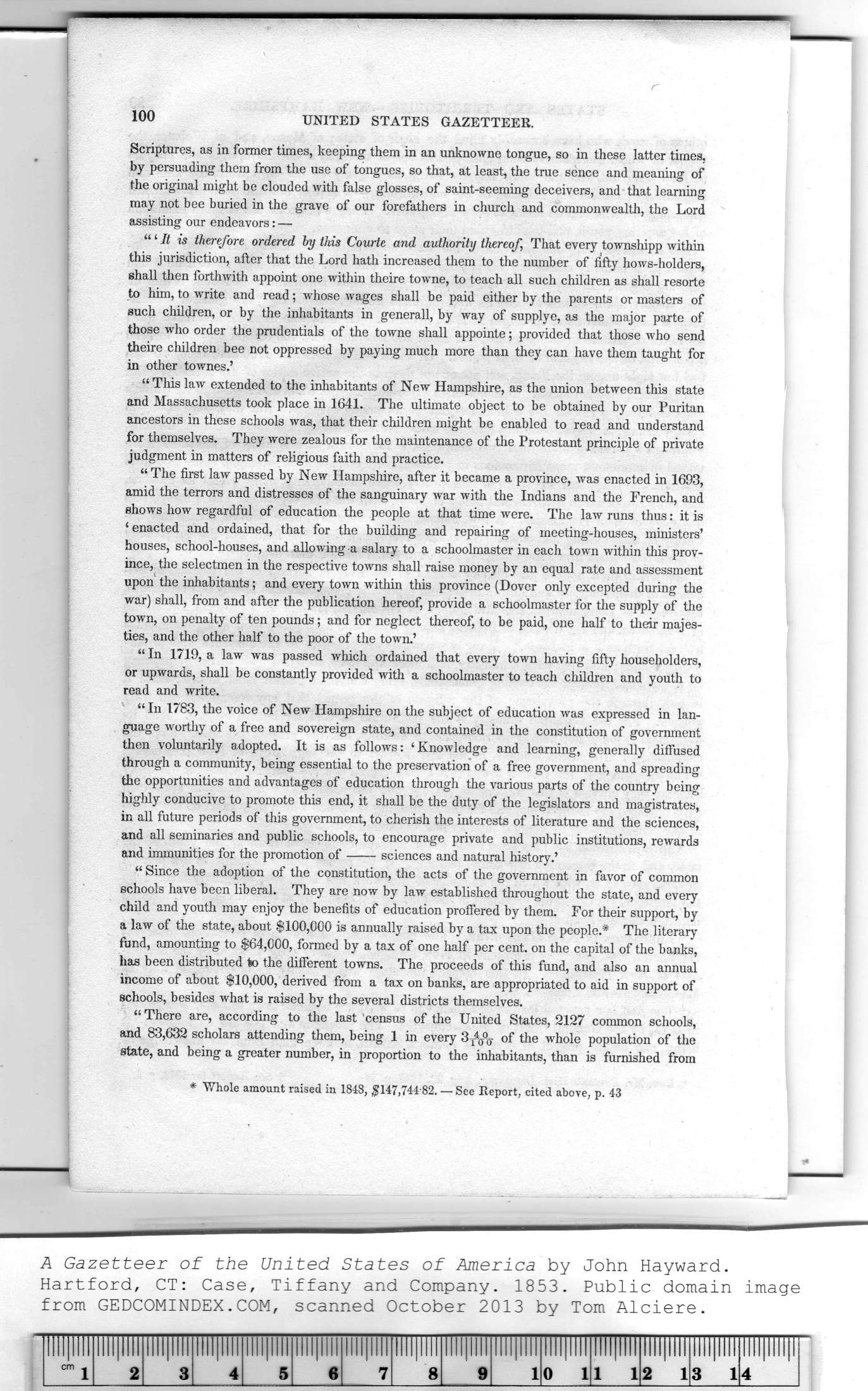|
|
Note: Ctrl and + increases the font size of the text below, Ctrl and - decreases it, and Ctrl and 0 resets it to default size.
100 UNITED STATES GAZETTEER.
Scriptures, as in former times, keeping them in an unknowne tongue, so in these latter times,
by persuading them from the use of tongues, so that, at least, the true sence and meaning of
the original might be clouded with false glosses, of saint-seeming deceivers, and that learning
may not bee buried in the grave of our forefathers in church and commonwealth, the Lord
assisting our endeavors: —
“ ‘ It is therefore ordered by this Courte and authority thereof, That every townshipp within
this jurisdiction, after that the Lord hath increased them to the number of fifty hows-holders,
shall then forthwith appoint one within theire towne, to teach all such children as shall resorte
to him, to write and read; whose wages shall be paid either by the parents or masters of
such children, or by the inhabitants in generall, by way of supplye, as the major parte of
those who order the prudentials of the towne shall appointe; provided that those who send
theire children bee not oppressed by paying much more than they can have them taught for
in other townes.'
“This law extended to the inhabitants of New Hampshire, as the union between this state
and Massachusetts took place in 1641. The ultimate object to be obtained by our Puritan
ancestors in these schools was, that their children might be enabled to read and understand
for themselves. They were zealous for the maintenance of the Protestant principle of private
judgment in matters of religious faith and practice.
“The first law passed by New Hampshire, after it became a province, was enacted in 1693,
amid the terrors and distresses of the sanguinary war with the Indians and the French, and
shows how regardful of education the people at that time were. The law runs thus: it is
‘enacted and ordained, that for the building and repairing of meeting-houses, ministers'
houses, school-houses, and allowing a salary to a schoolmaster in each town within this prov-
ince, the selectmen in the respective towns shall raise money by an equal rate and assessment
upon the inhabitants; and every town within this province (Dover only excepted during the
war) shall, from and after the publication hereof, provide a schoolmaster for the supply of the
town, on penalty of ten pounds; and for neglect thereof, to be paid, one half to their majes-
ties, and the other half to the poor of the town.'
“ In 1719, a law was passed which ordained that every town having fifty householders,
or upwards, shall be constantly provided with a schoolmaster to teach children and youth to
read and write.
“In 1783, the voice of New Hampshire on the subject of education was expressed in lan-
guage worthy of a free and sovereign state, and contained in the constitution of government
then voluntarily adopted. It is as follows: ‘Knowledge and learning, generally diffused
through a community, being essential to the preservation of a free government, and spreading
the opportunities and advantages of education through the various parts of the country being
highly conducive to promote this end, it shall be the duty of the legislators and magistrates,
in all future periods of this government, to cherish the interests of literature and the sciences,
and all seminaries and public schools, to encourage private and public institutions, rewards
and immunities for the promotion of sciences and natural history.'
“ Since the adoption of the constitution, the acts of the government in favor of common
schools have been liberal. They are now by law established throughout the state, and every
child and youth may enjoy the benefits of education proffered by them. For their support, by
a law of the state, about $100,000 is annually raised by a tax upon the people.* The literary
fund, amounting to $64,000, formed by a tax of one half per cent, on the capital of the banks,
has been distributed k> the different towns. The proceeds of this fund, and also an annual
income of about $10,000, derived from a tax on banks, are appropriated to aid in support of
schools, besides what is raised by the several districts themselves.
“There are, according to the last census of the United States, 2127 common schools,
and 83,632 scholars attending them, being 1 in every 3-^°^ of the whole population of the
state, and being a greater number, in proportion to the inhabitants, than is furnished from
* Whole amount raised in 1848, $147,744-82. — See Report, cited above, p. 43
|
lllllllll |
iiiiliiii |
lllllllll |
lllllllll |
lllllllll |
llll|llll |
lllllllll |
lllllllll |
lllllllll |
lllllllll |
lllllllll |
lllllllll |
lllllllll |
lllllllll |
|
|
cm j |
2 |
3 |
4 |
5 |
6 |
7 |
8 |
9 |
1 |
0 1 |
1 1 |
2 1 |
3 1 |
4 |
|
